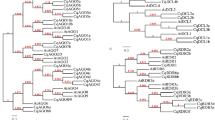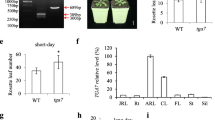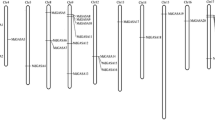Abstract
To isolate differentially expressed genes during the juvenile-to-adult phase transition of an early-flowering trifoliate orange mutant (precocious trifoliate orange, Poncirus trifoliata), suppression subtractive hybridization was performed. In total, 463 cDNA clones chosen by differential screening of 1,920 clones were sequenced and 178 differentially expressed genes were identified, among which 41 sequences did not match any known nucleotide sequence. Analysis of expression profiles of the differentially expressed genes through hybridization on customized chips revealed their expression change was associated with the phase transition from juvenile to adult in the mutant. Open reading frames of nine selected genes were successfully determined by rapid amplification of cDNA ends. Expression analysis of these genes by real-time RT-PCR showed that transcript levels of several genes were associated with floral induction and inflorescence development. Among these genes, HM596718, a sequence sharing a high degree of similarity with Arabidopsis EARLY FLOWERING 5 (AtELF5) was discovered. Real-time PCR and in situ hybridization indicated its expression pattern was closely correlated with floral induction and flowering of the mutant. Ectopic expression of the gene in Arabidopsis caused early flowering; however, its functional characterization is different than the role of AtELF5 observed in Arabidopsis. A yeast two-hybrid assay indicated that PtELF5 significantly interacted with DUF1336 domain of a hypothetical protein, which has not yet been functionally characterized in woody plants. These findings suggest that PtELF5 may be a novel gene that plays an important role during the early flowering of precocious trifoliate orange.









Similar content being viewed by others
References
Amasino R (2004) Vernalization, competence, and the epigenetic memory of winter. Plant Cell 16:2553–2559
Baurle I, Dean C (2006) The timing of developmental transitions in plants. Cell 125:655–664
Carmona MJ, Cubas P, Calonje M, Martinez-Zapater JM (2007) Flowering transition in grapevine (Vitis vinifera L.). Botany 85:701–711
Chen M, Ni M (2006) RFI2, a RING-domain zinc finger protein, negatively regulates CONSTANS expression and photoperiodic flowering. Plant J 46:823–833
Clough SJ, Bent AF (1998) Floral dip: a simplified method for Agrobacterium-mediated transformation of Arabidopsis thaliana. Plant J 16:735–743
Conesa A, Gotz S, García-Gómez JM, Terol J, Talon M, Robles M (2005) Blast2GO: a universal tool for annotation, visualization and analysis in functional genomics research. Bioinformatics 21:3674–3676
Corbesier L, Coupland G (2006) The quest for florigen: a review of recent progress. J Exp Bot 57:3395–3403
Deal RB, Topp CN, McKinney EC, Meagher RB (2007) Repression of flowering in Arabidopsis requires activation of FLOWERING LOCUS C expression by the histone variant H2A. Z. Plant Cell 19:74–83
Diatchenko L, Lau YFC, Campbell AP, Chenchik A, Moqadam F, Huang B, Lukyanov S, Lukyanov K, Gurskaya N, Sverdlov ED, Siebert PD (1996) Suppression subtractive hybridization: a method for generating differentially regulated or tissue-specific cDNA probes and libraries. Proc Natl Acad Sci USA 93:6025–6030
Du X, Xiao Q, Zhao R, Wu F, Xu Q, Chong K, Meng Z (2008) TrMADS3, a new MADS-box gene, from a perennial species Taihangia rupestris (Rosaceae) is upregulated by cold and experiences seasonal fluctuation in expression level. Dev Genes Evol 218:281–292
Duarte JM, Cui LY, Wall PK, Zhang Q, Zhang XH, Leebens-Mack J, Ma H, Altman N, de Pamphilis CW (2006) Expression pattern shifts following duplication indicative of subfunctionalization and neofunctionalization in regulatory genes of Arabidopsis. Mol Bio Evol 23:469–478
Fernandez L, Torregrosa L, Terrier N, Sreekantan L, Grimplet J, Davies C, Thomas MR, Romieu C, Ageorges A (2007) Identification of genes associated with flesh morphogenesis during grapevine fruit development. Plant Mol Biol 63:307–323
Ferrario S, Immink RGH, Angenent GC (2004) Conservation and diversity in flower land. Curr Opin Plant Biol 7:84–91
Gietz D, St Jean A, Woods RA, Schiestl RH (1992) Improved method for high efficiency transformation of intact yeast cells. Nucleic Acids Res 20:1425
Greenwood MS (1987) Rejuvenation of forest trees. Plant Growth Regul 6:1–12
Hackett WP (1985) Juvenility, maturation, and rejuvenation in woody plants. Hort Rev 7:109–155
Hayama R, Coupland G (2004) The molecular basis of diversity in the photoperiodic flowering responses of Arabidopsis and rice. Plant Physiol 135:677–684
Henderson IR, Dean C (2004) Control of Arabidopsis flowering: the chill before the bloom. Development 131:3829–3838
Jaya ES, Clemens J, Song J, Zhang H, Jameson PE (2010) Quantitative expression analysis of meristem identity genes in Eucalyptus occidentalis: AP1 is an expression marker for flowering. Tree Physiol 30:304–312
Kobayashi Y, Kaya H, Goto K, Iwabuchi M, Araki T (1999) A pair of related genes with antagonistic roles in mediating flowering signals. Science 286:1960
Komuro A, Saeki M, Kato S (1999) Association of two nuclear proteins, Npw38 and NpwBP, via the interaction between the WW domain and a novel proline-rich motif containing glycine and arginine. J Biol Chem 274:36513–36519
Krajewski AJ, Rabe E (1995) Citrus flowering: a critical evaluation. J Hort Sci 70:357–374
Lee JH, Cho YS, Yoon HS, Suh MC, Moon JH, Lee I, Weigel D, Yun CH, Kim JK (2005) Conservation and divergence of FCA function between Arabidopsis and rice. Plant Mol Biol 58:823–838
Li JJ, Jia DX, Chen XM (2001) HUA1, a regulator of stamen and carpel identities in Arabidopsis, codes for a nuclear RNA binding protein. Plant Cell 13:2269–2281
Li ZM, Zhang JZ, Mei L, Deng XX, Hu CG, Yao JL (2010) PtSVP, an SVP homolog from trifoliate orange (Poncirus trifoliata L. Raf.), shows seasonal periodicity of meristem determination and affects flower development in transgenic Arabidopsis and tobacco plants. Plant Mol Biol 74:129–142
Liang S, Wang X, Wan T (1999) Precocious trifoliate orange (Poncirus trifoliata L. Raf.) biology characteristic and its stock experiment. ZheJiang Citrus 16:2–4 (in Chinese)
Lim MH, Kim J, Kim YS, Chung KS, Seo YH, Lee I, Kim J, Hong CB, Kim HJ, Park CM (2004) A new Arabidopsis gene, FLK, encodes an RNA binding protein with K homology motifs and regulates flowering time via FLOWERING LOCUS C. Plant Cell 16:731–740 (online version contains web-only data)
Lorkovic ZJ, Barta A (2002) Genome analysis: RNA recognition motif (RRM) and K homology (KH) domain RNA-binding proteins from the flowering plant Arabidopsis thaliana. Nucleic Acids Res 30:623–635
McNellis TW, Arnim AG, Deng XW (1994) Overexpression of Arabidopsis COP1 results in partial suppression of light-mediated development: evidence for a light-inactivable repressor of photomorphogenesis. Plant Cell 6:1391–1400
Michaels SD, Amasino RM (1999) FLOWERING LOCUS C encodes a novel MADS domain protein that acts as a repressor of flowering. Plant Cell 11:949–956
Mouradov A, Cremer F, Coupland G (2002) Control of flowering time: interacting pathways as a basis for diversity. Plant Cell 14:S111–S130
Namasivayam P, Hanke D (2006) Identification of differentially expressed sequences in pre-embryogenic tissue of oilseed rape by suppression subtractive hybridisation (SSH). Plant Cell Tissue Organ Cult 86:417–421
Ng M, Yanofsky MF (2001) Function and evolution of the plant MADS-box gene family. Nat Rev Genet 2:186–195
Noh YS, Bizzell CM, Noh B, Schomburg FM, Amasino RM (2004) EARLY FLOWERING 5 acts as a floral repressor in Arabidopsis. Plant J 38:664–672
Pang XM, Wen XP, Hu CG, Deng XX (2006) Genetic diversity of Poncirus accessions as revealed by amplified fragment length polymorphism (AFLP). J Hortic Sci Biotech 81:269–275
Parcy F (2005) Flowering: a time for integration. Int J Dev Biol 49:585–593
Pillitteri LJ, Lovatt CJ, Walling LL (2004a) Isolation and characterization of a TERMINAL FLOWER homolog and its correlation with juvenility in citrus. Plant Physiol 135:1540–1551
Pillitteri LJ, Lovatt CJ, Walling LL (2004b) Isolation and characterization of LEAFY and APETALA1 homologues from Citrus sinensis L. Osbeck ‘Washington’. J Am Soc Hortic Sci 129:846–856
Putterill J, Laurie R, Macknight R (2004) It’s time to flower: the genetic control of flowering time. BioEssays 26:363–373
Ranjan P, Kao YY, Jiang HY, Joshi CP, Harding SA, Tsai CJ (2004) Suppression subtractive hybridization-mediated transcriptome analysis from multiple tissues of aspen (Populus tremuloides) altered in phenylpropanoid metabolism. Planta 219:694–704
Rice JC, Allis CD (2001) Histone methylation versus histone acetylation: new insights into epigenetic regulation. Curr Opin Cell Biol 13:263–273
Sablowski RWM, Meyerowitz EM (1998) A homolog of NO APICAL MERISTEM is an immediate target of the floral homeotic genes APETALA3/PISTILLATA. Cell 92:93–103
Sheldon CC, Rouse DT, Finnegan EJ, Peacock WJ, Dennis ES (2000) The molecular basis of vernalization: the central role of FLOWERING LOCUS C (FLC). Proc Natl Acad Sci USA 97:3753–3758
Simpson GG, Dean C (2002) Flowering: Arabidopsis, the Rosetta stone of flowering time? Science 296:285–289
Takeda S, Matsumoto N, Okada K (2004) RABBIT EARS, encoding a SUPERMAN-like zinc finger protein, regulates petal development in Arabidopsis thaliana. Development 131:425–434
Talon M, Gmitter FG Jr (2008) Citrus genomics. Int J Plant Genomics 2008:528361
Tan FC, Swain SM (2007) Functional characterization of AP3, SOC1 and WUS homologues from citrus (Citrus sinensis). Physiol Plant 131:481–495
Theien G, Saedler H (1999) The golden decade of molecular floral development (1990–1999): a cheerful obituary. Dev Genet 25:181–193
Tsuwamoto R, Fukuoka H, Takahata Y (2007) Identification and characterization of genes expressed in early embryogenesis from microspores of Brassica napus. Planta 225:641–652
Wigge PA, Kim MC, Jaeger KE, Busch W, Schmid M, Lohmann JU, Weigel D (2005) Integration of spatial and temporal information during floral induction in Arabidopsis. Science 309:1056–1059
Yan L, Loukoianov A, Blechl A, Tranquilli G, Ramakrishna W, San Miguel P, Bennetzen JL, Echenique V, Dubcovsky J (2004) The wheat VRN2 gene is a flowering repressor down-regulated by vernalization. Science 303:1640–1644
Yao JL, Zhou Y, Hu CG (2007) Apomixis in Eulaliopsis binata: characterization of reproductive mode and endosperm development. Sex Plant Reprod 20:151–158
Yoo SY, Kim Y, Kim SY, Lee JS, Ahn JH (2007) Control of flowering time and cold response by a NAC-domain protein in Arabidopsis. PLoS One 2:e642
Zhang JZ, Li ZM, Mei L, Yao JL, Hu CG (2009a) PtFLC homolog from trifoliate orange (Poncirus trifoliata) is regulated by alternative splicing and experiences seasonal fluctuation in expression level. Planta 229:847–859
Zhang JZ, Li ZM, Yao JL, Hu CG (2009b) Identification of flowering-related genes between early flowering trifoliate orange mutant and wild-type trifoliate orange (Poncirus trifoliata L. Raf.) by suppression subtraction hybridization (SSH) and macroarray. Gene 430:95–104
Zhang JZ, Ai XY, Sun LM, Zhang DL, Guo WW, Deng XX, Hu CG (2011) Transcriptome profile analysis of flowering molecular processes of early flowering trifoliate orange mutant and the wild-type [Poncirus trifoliata (L.) Raf.] by massively parallel signature sequencing. BMC Genomics 12(1):63
Acknowledgments
This research was supported financially by the National Natural Science Foundation of China (Grant nos. 30971973, 31071777, 30921002) and the Science Foundation of the Doctoral Discipline of the Chinese Ministry of Education (Grant no. 20090146110009), the Fundamental Research Funds for the Central Universities, the 863 Project of China (Twelfth five) and the Project of 948 from Ministry of Agriculture of China (Grant no. 2011G21).
Author information
Authors and Affiliations
Corresponding author
Electronic supplementary material
Below is the link to the electronic supplementary material.
Rights and permissions
About this article
Cite this article
Zhang, JZ., Ai, XY., Sun, LM. et al. Molecular cloning and functional characterization of genes associated with flowering in citrus using an early-flowering trifoliate orange (Poncirus trifoliata L. Raf.) mutant. Plant Mol Biol 76, 187–204 (2011). https://doi.org/10.1007/s11103-011-9780-2
Received:
Accepted:
Published:
Issue Date:
DOI: https://doi.org/10.1007/s11103-011-9780-2




